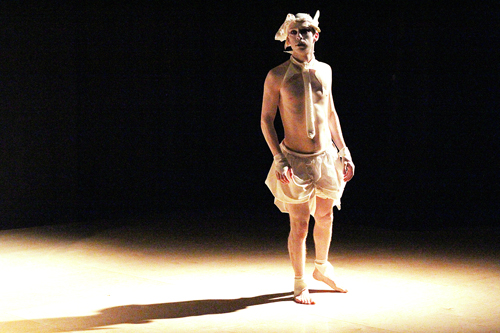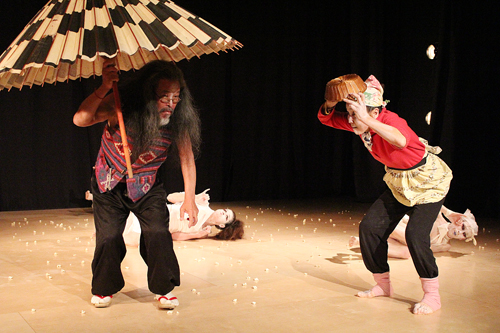
On the outskirts of North Portland, the Headwaters Theatre stands tucked against a stretch of rail yard on the edge of the Piedmont District. Here, the theater’s founder, Mizu Desierto, often plays host to contemporary art and dance originating locally and abroad.
But, recently, Headwaters held an event showcasing its own exploration of local art practice. The result: a documentary written and directed by Desierto titled The Local Culture Project.
Last Friday and Saturday, the film premiered at Headwaters, where patrons were invited to view the film over coffee and saké. Afterward, Desierto and others performed a Japanese Butoh dance, created by artist-in-residence Hiroko Tamano, before leading a discussion about the projects.
But what is Culture about, exactly? As Desierto explained, the film came about as she and fellow dancer Kestrel Gates began asking questions about how their art would continue developing as they incorporated their daily lives into it.

“We started to ask ourselves, what are the origins of dance? What are the origins of creativity in relation to culture, community and family?” Desierto said. “In our culture, there are all these many ways in which art’s been separated and segregated, and we have all these different hierarchies of what it means to be an artist. Someone who’s in a domestic role is usually not included in that.”
Desierto and Gates decided to explore the question in depth with a group of women from different art backgrounds. Over the course of a year, they filmed their trials and triumphs as they attempted to weave the art of dance with chores and other demands of daily life. The group hoped to capture the joy of little moments through movement.
“Rather than go to the studio to make a project, let’s go to each other’s homes,” Desierto explained. “Let’s share in some household chores. Let’s help plant seeds. And also dance. And see what is the relationship. And what it will look like if children join us.”
They sought to tie their work to the idea of sustainable living. The group organized a summer program, including a course at Portland State, integrating permaculture and Japanese Butoh dance.
“Permaculture is more clearly scientifically on the path of sustainability, and Butoh is this contemporary Japanese form that was a demand for a more sustainable human,” Desierto said.
The dance performance following the film was a work of symbolism and abstraction called “In the Daily Life.” Performed by Desierto, Meghann Rose, KejAnne Pepper and Hiroko and Koichi Tamano, the work journeyed through silence and song, depicting sensuality and innocence, tension and grace.
The younger dancers starred in the bulk of the performance, embodying mountains, the sphinx, a marketplace, angels, infants and more. The veteran Tamanos—both of whom played a role in bringing Butoh to the U.S. from Japan—made a brief, whimsical appearance by scattering popcorn over the stage and hefting a decorative parasol as they scurried between the unmoving dancers.
“It is not very busy,” Hiroko Tamano said of the performance piece. “Tide goes up and tide goes down, kind of like the breaths of nature.”
The dancers noted the many layers of choreography at play. Desierto said she continues to learn new things about each moment every time she performs it. Tamano, who arranged the performance, said that she prefers to work with her dancers over the long term.
“Even one simple choreography needs time to grow,” she said.
When asked about the evolution of Butoh into a modern dance, Koichi Tamano (via a translator) explained his lifelong experience of Butoh, which included his slowly abandoning classical ballet for the contemporary dance form early in his career. Eventually, he and Hiroko came to live in San Francisco, where they opened a studio to teach the style.
“The environment of the two eras is different,” he said. “The way people lived in the ’60s was very different from now. If life changes, so does the dance that comes out of life.”
Butoh is a contemporary dance style founded in Japan by Tatsumi Hijikata in response to the westernization of Japanese culture. The form reaches for a more primordial expression of self through the embodiment of natural things, according to Desierto.
“What makes it different from other dance forms is it’s a lively play with the imagination. The goal is to erase the human being and really be the essence of whatever quality you’re trying to penetrate,” Desierto said. “Often it’s very dark, crazy and smells are involved. It’s really about revitalizing the whole body and the senses and to open and express with a more integrated body and mind.”
The Local Culture Project was funded with the help of Portland State’s Institute for Sustainable Solutions and Center for Japanese Studies as well as the Oregon Regional Arts and Culture Council and Oregon Arts Commission.
Although the dance is intricate and involved, the goal is simple: to help connect people’s art with their lives. And it’s just one step of a longer journey.
“By the end, we were really just recognizing that the questions we were calling into our lives are kind of lifelong questions,” Desierto said. “Whether we’re doing it through dance or retraining ourselves to do simple things like grow beans, the world is demanding that we become more simple in some ways. It’s a much larger, lifelong process.”

